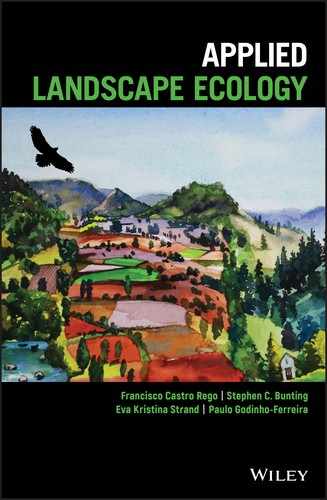Foreword
As urbanization spreads swiftly and visibly across the land and climate change promises further severe effects, increasingly landscape ecology is needed at the core of solutions. Building from the basic patch–corridor–matrix model and an array of spatial principles, the field describes, analyzes, and prescribes patterns for science and society. Not surprisingly, landscape ecology has strengthened key dimensions of forestry, conservation biology, wildlife management, landscape architecture, transportation, and urban planning.
Along with principles and applications, theory has grown, as noted by Princeton ecologist, Simon Levin, who participated in landscape ecology’s 1983 North American launching: “…landscape ecology has developed into one of the most vibrant branches of ecological science, with exceptionally strong links between theory and practice. Indeed, it is hard to think of any area in ecology where theory has had a greater impact on application, or where applications have done more to stimulate creative theory.” (Foreword to Barrett, G.W., Barrett, T.L., and Wu, J. (eds) (2015) History of Landscape Ecology in the United States, Springer.)
Several valuable landscape ecology books are used in teaching and applications. Yet students, professors, and practitioners alike would welcome a succinct, well‐illustrated handbook of core principles, plus equations, highlighting how to measure and analyze patterns that affect processes. This is now in your hand.
Global in perspective, the book builds on a tradition of joint North American and European co‐authors (Forman books with, respectively, French (Landscape Ecology, John Wiley & Sons, 1986), Dutch (Changing Landscapes: An Ecological Perspective, Springer, 1990), and Norwegian (Landscape Ecology Principles in Landscape Architecture and Land‐Use Planning, 2nd edn, Island Press, 1996) co‐authors). Embellishing the pages of this book are examples from islands and arid lands to forests and agriculture, even cities.
The authors begin with a somewhat novel organizing theme, points, lines, and patches. For each, simple familiar patterns, formulas, examples, and analyses are presented, and gradually build to slightly more complex principles. The approach is amazingly logical and lucid. The reader explores the core of landscape ecology and grasps the essence of concepts. Subsequent chapters highlight the vertical dimension, movement through landscapes, composition, configuration, and landscape dynamics, using the earlier basics in progressively more complex analyses. Each of these later chapters takes an extra step or two, opening up useful frontiers. The final chapter applies the principles and tools, along with the transition matrix, to landscape planning and management.
This book emerges from researchers with years of teaching landscape ecology. While reading, I felt an author was in the room with me talking through concepts, and showing how to measure and analyze the diverse patterns outside. The delightfully clear writing and explanations made some previously muddy ideas crystallize, eureka‐like.
Imagine having the following for both teaching and learning: abundant illustrations, often in color, of the place, pattern, and/or species considered; many key landscape ecologists briefly introduced with a photograph; frequent GIS vector, or especially clear raster, representations and analyses; patterns often compared, using equations and empirical data; classic, as well as new, field studies analyzed; metrics for detecting pattern and interpreting process; how to calculate common indices; full references given as Endnotes at the end of each chapter where cited; and every chapter with succinctly stated key points.
Frontiers for landscape ecology abound. Land patterns are crucial for towns/villages and their surroundings. The big picture is still needed for cities/suburbs (e.g., Urban Ecology: Science of Cities, Cambridge, 2014), urban regions (Urban Regions: Ecology and Planning Beyond the City, Cambridge, 2008), and transportation (Handbook of Road Ecology, John Wiley & Sons, 2015). Solutions on the border of vision and feasibility, such as for transportation (Solutions, 2, 10–23, 2011) and best places for the next billion people (Nature, 537, 608–611, 2016; Handbook on Biodiversity and Ecosystem Services in Impact Assessment, Edward Elgar, 2016), build on landscape ecology. Economists and other social scientists, who relish equations and horizontal axes representing time, could richly add to this field. Landscape ecology books with, or for, planners could quickly change planning and improve our land. Opportunities await.
Turning the pages ahead reveals a unique book. All landscape ecologists and related colleagues will value, and should have, these lucid explanations of core principles using analytic methods. This volume is valuable for academics teaching a course, researchers face‐to‐face with landscape patterns, and perceptive practitioners improving our land.
